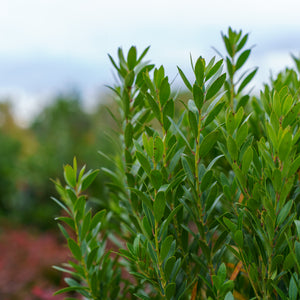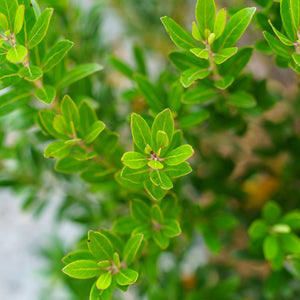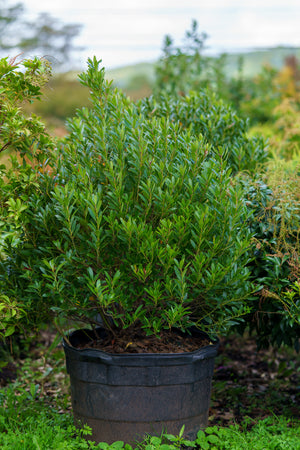Shamrock Inkberry Holly: A Native Evergreen Built for Structure
Welcome to this week’s edition of our "Plant of the Week" series. When it comes to low-maintenance, evergreen structure with native roots and polished form, few shrubs perform as consistently as the Shamrock Inkberry Holly (Ilex glabra 'Shamrock'). Compact, adaptable, and reliably green all year, Shamrock is a foundational plant for both modern landscapes and ecological designs. Whether you're building borders, hedges, or wildlife-friendly plantings, this native broadleaf evergreen deserves a spot in your landscape.
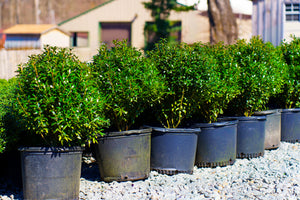
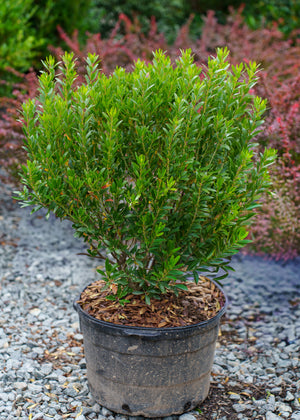
What Makes Shamrock Inkberry Holly Special?
Shamrock is a compact selection of native Inkberry Holly, chosen for its tight, rounded habit, slow growth, and dense branching. Unlike leggier wild types, 'Shamrock' maintains a refined shape with minimal pruning, growing 3 to 4 feet tall and spreading 3 to 4 feet wide at maturity.
The foliage is one of its standout features—small, glossy, deep green leaves that remain attractive throughout the year without bronzing or dropping in winter. In spring, inconspicuous white flowers attract pollinators, and female plants (when pollinated) can produce small black berries that persist into winter and provide food for birds.
As a native species, Inkberry is well adapted to the mid-Atlantic climate and performs reliably across USDA Zones 5 to 9. It tolerates moist or poorly drained soils, thrives in full sun to part shade, and is deer-resistant, making it especially useful in areas where browsing is a concern.
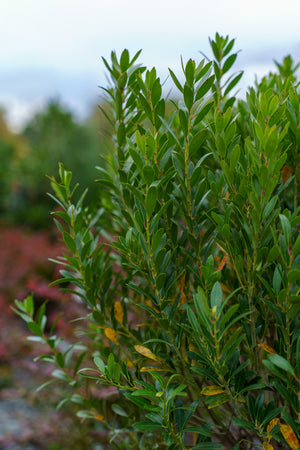
How to Use Shamrock Inkberry Holly in the Garden
Shamrock’s neat shape and evergreen foliage make it one of the most versatile native shrubs you can plant.
Foundation and Border Plantings
Shamrock Inkberry excels in foundation beds, where its tidy shape and year-round color offer structure and contrast. It’s a great substitute for boxwood in areas where boxwood blight or winter burn are concerns.
Native and Pollinator Gardens
As a native alternative to imported evergreens, Shamrock supports biodiversity and fits seamlessly into pollinator or bird-friendly gardens. Its spring flowers benefit native bees, and its berries attract birds through the fall and early winter.
Low Hedges and Mass Plantings
Plant in rows for a low hedge or in staggered groups for a mass planting that offers evergreen coverage without harsh lines. Spaced 3 to 4 feet apart, Shamrock will knit together over time to form a dense, low-maintenance screen.
Rain Gardens and Moist Soils
Shamrock is highly tolerant of wet or seasonally saturated soils, making it a smart choice for rain gardens, swales, or the low spots in your yard where other evergreens fail.
Focal Point for Small Spaces
Though often used in groups, a well-positioned Shamrock Inkberry can serve as a subtle focal point in a small courtyard or entry bed, especially when framed with mulch or winter-interest perennials like hellebores or coral bells.
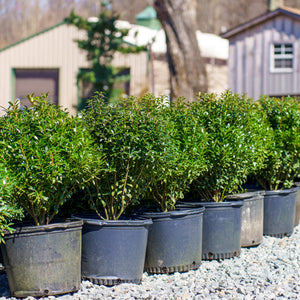
How to Care for Shamrock Inkberry Holly
Shamrock Inkberry is easy to maintain and long-lived with just a few basic care guidelines:
Planting: Choose a location with full sun to part shade. Soil should be acidic, moist, and well-drained, though Shamrock is tolerant of wetter sites than most hollies.
Watering: Keep soil evenly moist during establishment. Once mature, Shamrock tolerates both periodic wetness and brief drought, though it prefers consistent moisture.
Pruning: Prune in late winter or early spring if shaping is needed, though Shamrock rarely requires it. Occasional thinning can help increase air circulation in dense plantings.
Fertilizing: Apply a slow-release fertilizer for acid-loving plants in early spring if needed. Avoid heavy feeding, which can lead to excessive leaf growth and reduced density.
Spacing: For hedges or groupings, space plants 3 to 4 feet apart. Allow room for airflow to reduce disease risk in damp sites.
Pests & Disease: Shamrock is generally pest-free, with strong resistance to deer, winter burn, and boxwood blight. It may show signs of chlorosis in high pH soils—use soil amendments or iron treatments to correct as needed.
CONCLUSION
Shamrock Inkberry Holly (Ilex glabra 'Shamrock') combines the polish of a classic evergreen with the resilience and ecological value of a native species. Its tidy growth, moisture tolerance, and all-season foliage make it an essential tool for designers and homeowners alike—especially in gardens that demand structure, function, and natural beauty. Whether you’re building a border, buffering a rain garden, or crafting a native foundation planting, Shamrock delivers quiet strength and year-round appeal.

